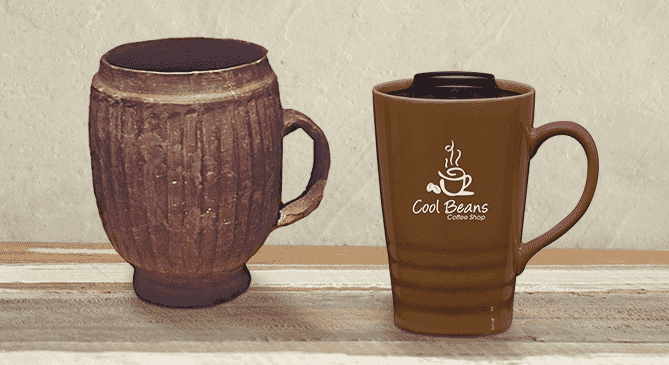The History of Travel Mugs & Tumblers by Gatha Bhuva 22BDI008
The History of Travel Mugs & Tumblers

10000 BCE
· The oldest mugs were made of bone and had no handles. They were produced during the Neolithic Stone Age.
· However, wooden mugs have proven to be far more difficult to preserve than the earliest mugs thought to date from this period.
· Try using a wood tone version of our well-liked Himalayan tumblers to imprint your company logo on a mug that will endure the test of time.
4000-5000
· At some point, clay was used to make mugs. This made it much simpler to decorate the cups and add handles.
· Around 2000 BCE, the earliest ceramic cups created on a potter's wheel were discovered.
· The clay used at this time made the walls of the mug too thick for a human mouth to comfortably drink from.
2000 BCE
· With the evolution of metal work, walls became thinner.
· Metal mugs were produced using lead, gold, silver, or bronze.
· These were difficult to drink hot beverages from.
206 BCE–220 CE
· High-fired porcelain was widely used to create ceramics between the years of 206 BCE and 220 CE, despite the fact that its origins are thought to have been in China much earlier.
· Porcelain is still the most often used materials in ceramic drink ware and is more typical for regular coffee cups.
· Due to its thin walls and versatility in holding hot or cold beverages, porcelain and other ceramic materials have emerged as some of the greatest options for mug production.
1600s-1700s CE
· Coffee was discovered approximately 850 CE, and mugs were used to consume it as its popularity grew.
· Because they resembled prisoner profiles, or "mug shots," people started calling these kinds of cups "mugs."
· When cups with rounded bottoms first came into use, the word "tumbler" was employed. It is not obvious why this is.
· A royal decree to highly tax coffee was implemented in Sweden in 1746.
· If one didn't pay this tax, they would receive a fine and their coffee accessories, such as mugs, would be taken away. The bootlegging of these goods increased later that year when coffee was completely forbidden.
1892-1904 CE
· In 1892, Sir James Dewar created the "vacuum flask," or vacuum insulation technique, to maintain the proper temperature for his Palladium.
· Chemical experimentation started using this technique often.
· Two glassblowers from Germany discovered that the vacuum technology could be used commercially to keep drinks cold or warm. Because Dewar had never patented the vacuum flask, the two took the rights to the double wall insulated cup and renamed it "thermos" in 1904.
· Many years later, the phrase began to be used to refer to any object with vacuum flask characteristics, which led to the thermos trademark becoming more widely used.
1945
· The traditional "coffee mug" was designed in 1945 by the Victor Insulator Company.
· The cups were built to military standards. They featured thick walls to ensure proper insulation and extra weight to prevent falls while being used on war ships.
· A rougher bottom was added to prevent the cup from sliding.
· The cups were made to meet military specifications. While being utilized on war ships, they had strong walls to provide optimum insulation and added weight to prevent collapses.
1980-1994 CE
· The advent of coffee club promotions at convenience stores, which offered customers discounts on refills when they bought a mug, led to the widespread use of travel mugs.
· "Trip sips" plastic mugs gained popularity because they could be mounted to a dashboard and frequently had a corporate imprint.
· The minivan was created in 1983. The modern kind of cup holders was incorporated into the dashboard of this new type of car.
Present
· Nowadays, new and innovative mugs are being brought to market all the time. Some of these include:
o Travel mugs with detachable Bluetooth speakers and an integrated microphone for taking calls.
o Portable vacuum-insulated cup with an integrated coffee grinder.
o Floating confetti tumbler that is stylish and appealing.
o Drinks are kept hot or cold and look attractive in stainless steel travel mugs, which are always popular.
Comments
Post a Comment